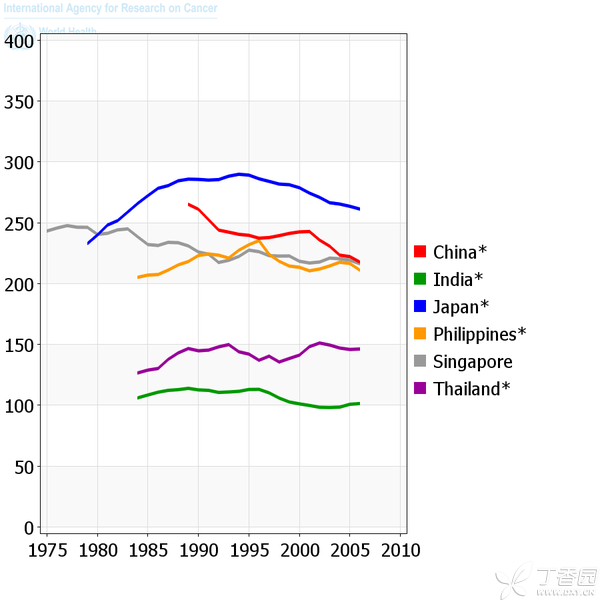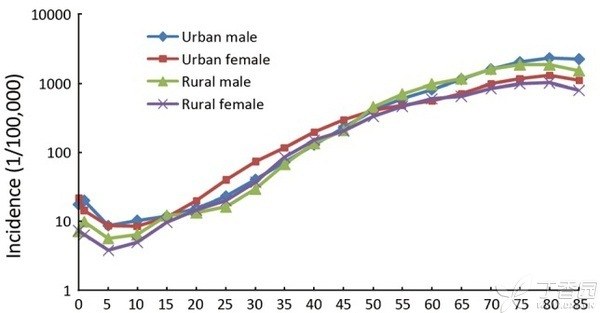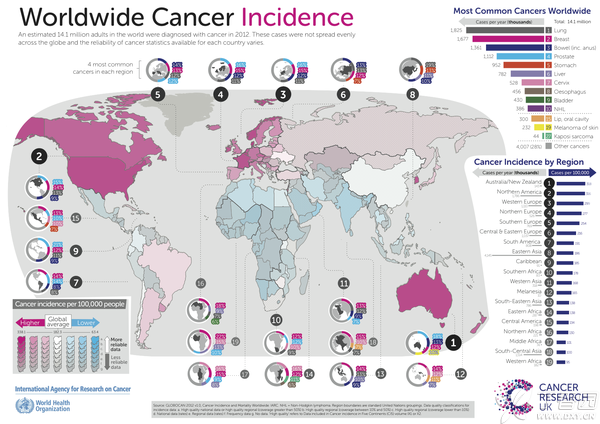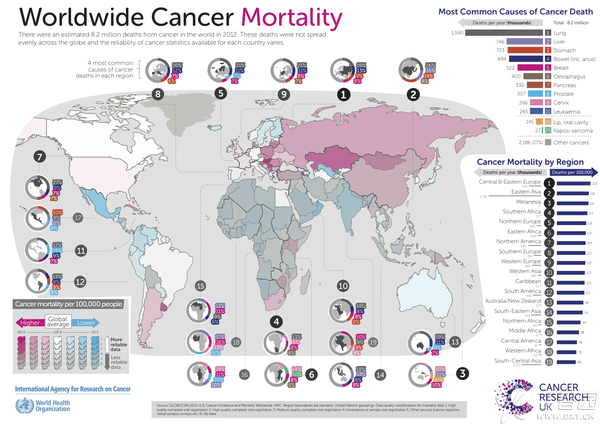
[More and more people feel that they have got cancer recently], whether online or offline, when chatting with friends and colleagues, everyone often has such feelings. So the author finally made up his mind to find relevant data to see if everyone’s feeling is reliable.
This is a very interesting question. I thought it would be necessary to search it once, but I couldn’t find a decent article after searching for half a day. Most of them are summaries and yearbooks of cancer incidence in a single year, lacking long-term trend analysis.
Looking around, I finally found some data in Globocan 2012 [1].
In terms of cancer incidence, Globocan adopts the concept of age-standardized rate (ASR).
This is because cancer is a disease strongly related to age, and with the development of society, the proportion of people of different ages is also changing rapidly. Especially in countries like China, the population is aging.
In order to make the incidence rate of cancer comparable, it is necessary to use a virtual society with a fixed proportion as a reference to convert the incidence rate into the incidence rate under this [standard] society.

Figure 1 Total Cancer Incidence Rate of Men (Red Line Is China)

Figure 2 Cancer Incidence Rate of Women (Red Line Is China)
Obviously, although the incidence rate of cancer among Chinese men has not decreased much, it has been declining from the late 1980s to 2006, while the incidence rate of cancer among Chinese women is basically the same.
For each cancer, the data show that in China, the incidence of breast cancer, colorectal cancer and prostate cancer is increasing, while the incidence of other cancers is decreasing.
What about the cancer mortality rate in China?

Fig. 3 Cancer mortality rate in China (picture from Cancer Trends in China [2])
The figures show mortality rates for 1973-1975, 1990-1992, and 2004-2005, with total mortality rates on the left and Globocan standardized rates (ASR) on the right.
It can be seen that although the overall mortality rate is on the rise, if a fixed population composition is used as a reference, the mortality rate will still decline slightly between 1990 and 2005.
In other words, it seems that the proportion of cancer deaths is increasing, but that is because the number of elderly people with the highest proportion of cancer in the population is increasing.
In addition to age differences, urban-rural differences also have a big impact on the incidence of cancer.
Another article published on Ann Oncol in 2012 < > [3] confirmed this observation through data from different years and distinguished between urban and rural areas: in urban areas, cancer mortality is declining; However, in rural areas, it is flat (women) or has increased (men).
The cancer mortality rate in rural areas was lower than that in cities before, and by 2007-2009, it was higher than that in cities.
This article points out the huge difference between cancer mortality rates in rural and urban areas: in urban areas, almost all cancer mortality rates are declining (except for a few cancers such as colorectal cancer and breast cancer); In rural areas, the death rate of cancer is rising very fast, especially lung cancer.
Therefore, when we talk about cancer patients in China, we must also realize the huge difference between urban and rural areas in China.
Then why do you feel that the number of people who die of cancer is increasing?
This is because cancer occurs more frequently in the elderly. With the development of economy, the life expectancy continues to increase, and the number of people suffering from cancer is also steadily increasing.
Generally speaking, the more developed the country is, the longer the life expectancy is, the more complete the medical system is, and the more cancer patients will be.
To a large extent, this is because cancer is a [genetic disease]. It requires cells to acquire several variations, which change the main pathways that govern different functions of cells, including survival, growth, escape from immunity, angiogenesis, etc.
As a result, it can take more than ten years or even decades from the time when malignant tumors eventually occur to the time when they are detected and then to the time when they threaten people’s health and even life.
Therefore, the incidence of cancer usually increases with age.

Figure 4 Relationship between Cancer Incidence and Age in China (Above Figure from Chinese Journal of Cancer Research) [4]
As can be seen from the figure, Chinese cancer patients are no exception, and the incidence rate of cancer increases with age.
So, the basic logic is this: with the development of the economy, the sound health care system and the increase of life expectancy, many people finally have the opportunity to be targeted by cancer. Especially when the death rate of other major health killers, such as heart disease, is rapidly declining, the [long-term attack] of cancer makes people more anxious.
The incidence of cancer in China is lower than that in Europe and America?

Figure 5 Global Cancer Incidence Rate (Above from World Cancer Statistics: Cancer Research UK) [5]
As can be seen from the figure, judging from the average number of cancer patients, China is at a medium level in the world, which is still far from developed countries such as Europe and the United States.
Obviously, China is far inferior to Europe and the United States in the incidence of cancer.
Is the difference in cancer incidence the cause of what?
In fact, there are several factors.
1. Living habits
There is a classic study, It’s about cancer in Japanese-Americans. The incidence of gastric cancer in Japan, It is world-famous and high above the world. However, after investigation, it is found that the death rate of gastric cancer among Japanese-American citizens aged 45 to 64 has dropped a lot by the first generation of immigrants and by the second generation. Similarly, liver cancer has dropped less obviously. At the same time, colorectal cancer, which was originally very low, has caught up with whites. Research on Chinese immigrants has found similar findings.
This shows that the incidence rate of these cancers is not mainly due to ethnic differences, but to a large extent due to diet and living habits.
As immigrants accepted the American diet, the incidence characteristics of cancer also [American]. For example, it is generally believed that eating more meat is related to the incidence of colorectal cancer. When these Japanese immigrants come to the United States, it is estimated that the incidence of cancer will increase with big fish and big meat. However, the proportion of colorectal cancer is very small for black people living in relatively poor areas, such as Africa.
Not only that, the incidence of gastric cancer among white Americans has been declining since it was recorded in 1930. Why is this?
It is generally believed that the invention of refrigerators and the improvement of food preservation technology have reduced the probability of gastric cancer, esophageal cancer and nasopharyngeal cancer by eliminating the need to eat a lot of overnight decaying food.
Therefore, it is conceivable that with the development of society and the improvement of living standards, the incidence rate of gastric cancer in China is naturally declining. And colorectal cancer, it is difficult to say.
2. Other reasons
For example, cancers such as melanoma, white people in Europe and the United States have congenital disadvantages due to skin color, and the natural incidence rate will be high.
Another example is lung cancer, which is due to smoking and air quality problems.
However, liver cancer is mainly due to the long-term effect of hepatitis virus.
Why is the incidence of cancer high in Europe and America?
The high incidence of cancer in Europe and America is due to breast cancer and prostate cancer.
Interestingly enough, these two cancers, together with colorectal cancer, happen to be several cancers with rising incidence in Toury at the beginning. From the perspective of colorectal cancer, we know that this may be because our eating habits are beginning to eat more greasy things. However, breast cancer has also been shown to be related to living habits, such as the decline of fertility rate.
But the reason may not be the same. Because, these cancers are precisely cancers with very cheap and convenient early detection tools: colorectal cancer is to check hematochezia and then do colonoscopy; Breast cancer is examined by molybdenum target imaging, while prostate cancer is examined by blood prostate specific antigen (PSA).
How much impact can these tests themselves have on the incidence of cancer?
For example.
In the case of prostate cancer, the United States introduced PSA blood screening in 1988. The full implementation of the examination nearly doubled the number of prostate cancer in the United States in the early 1990s.
Unlike British doctors, American doctors use more radical chemotherapy and surgery to treat prostate cancer. Eventually, the death rate from prostate cancer in the United States began to be lower than that in Britain in the mid-1990s, at about 2/3 to 3/4. At the cost, the proportion of prostate cancer patients in the United States is more than twice that in Britain, and the social and medical costs are much higher.
Therefore, it depends on how you set this [standard]. In line with the United States, the proportion of prostate cancer will definitely go up (of course, hospitals and pharmaceutical factories will earn more).
You know, breast cancer and prostate cancer can already be said to be common diseases in the elderly. Anatomy of the dead shows that at least 2/3 of the elderly women have breast cancer and 80% of the men have prostate cancer, but most people will not die of these cancers.
The incidence of cancer in China is low, but the mortality rate is higher than that in Europe and America.

Figure 6 Global Cancer Mortality Rate (Above from Globocan) [6]
Another indirect evidence is the cancer mortality rate in our country. We can see from the figure that although our cancer incidence rate is lower than that in Europe and America, the mortality rate is higher. I think this is more reliable than the incidence rate and should be taken seriously.
Because this thing is a semi-subjective definition and is derived from symptoms, it is not so reliable to judge whether a person has suffered from a certain disease, especially in the early stage of the disease. However, it is not so difficult to judge whether a person died of a certain disease, because the person is already terminally ill and all characteristics are obvious.
The high mortality rate of cancer in our country may, of course, be due to the failure of treatment to keep up with it, or it may also be due to the gap in the diagnosis of cancer, which has caused many patients not to be found as early as possible, especially in rural areas.
Summary
To say the conclusion is to repeat it:
With the development of economy and the growth of life expectancy, the total number of people suffering from cancer should be steadily increasing.
On the whole, there is no reason to believe that the incidence rate of cancer through age stratification is increasing year by year, or even should be decreasing.
However, changes are taking place in specific cancers. This is more obvious in cancers such as lung cancer, gastric cancer and colorectal cancer.
